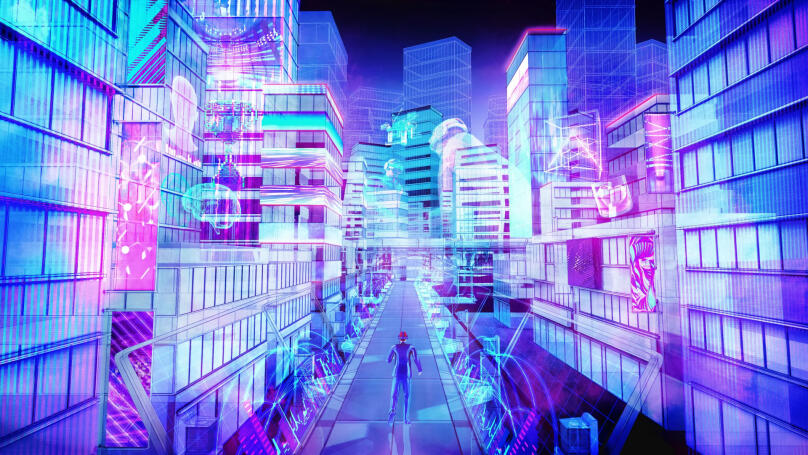Top Seven Biggest Metaverses in 2024
The year 2024 promises to be fantastic, thanks to meta universes.

You probably don't need to be told by now what it is. But in short, it is virtual or augmented reality, a digital space with extensive opportunities for interaction or work like real life. It is a full-fledged virtual world as a city of connected applications, services, or functions (not limited to a single platform). Moreover, since the IT sphere is moving forward by leaps and bounds, especially in VR and 3D, by 2030, the metaverse market promises to reach $615 billion. They originated in the gaming industry, but metaverses are gradually penetrating everything else, from social life to medicine and banking.
So, what are the biggest metaverses in 2024? Hint: they're all created and developed by the largest companies and corporations you probably already hear about. We've compiled a list of seven for you - and you can already join each of these metaverses! So, if you want to learn more about how to work with them, how they emerge and develop, and how to start creating your meta universe, we recommend taking our course "Metaverse for All: Dive into the Digital Realm."
1. Meta (Facebook)

Facebook is probably the largest and most famous meta universe, one of the first to emerge, so it can't be overlooked. So, the idea to create a full-fledged metaverse was announced by Mark Zuckerberg back in 2021, after which the company Facebook made a total rebranding with a change of name. Today, this universe includes social media platforms, Instagram, and other products and solutions designed specifically for business, work, and educational purposes. The Meta line even includes Ray-Ban Stories smart glasses with speaker and sensor, a portal for video calls, virtual reality headsets, and much more.
However, the most striking product of this metaverse is probably Meta Horizon - a platform with virtual rooms and spaces where people from all over the world can meet, communicate, negotiate, brainstorm, hold presentations or simply have fun. It's a kind of social network and cloud storage simultaneously, using avatars and gameplay. In practice, it looks like this: you create a character with your appearance and move around an imaginary brightly coloured city, like in a video game populated by living people (e.g., your colleagues). Then your characters come together, and that's how you get to work - both in the game and in reality simultaneously. Meta Horizon has been a lifesaver for many companies in quarantine, as it's ideal for coordinating remote teams.
2. Microsoft
Microsoft is another corporation that decided to keep up with global trends and competitors and launched its metaverse immediately after Facebook. It includes a whole line of platforms and software with augmented reality functions, operating mainly on the Windows system. And it all started with the invention of HoloLens virtual reality glasses back in 2016, designed for IT developers and businesses. Today, they are even used to design buildings and perform surgeries, as these glasses are equipped with a multitude of cameras and sensors that allow you to analyse and calculate data in real time.
On the other hand, the key project of Microsoft's meta universe is Mesh, a collaboration platform like Meta Horizon. It represents virtual spaces for meetings using characters, but it also works on mobile devices. You can create your rooms and arenas here, but you'll need special VR headsets for all of this.
Microsoft is also harnessing artificial intelligence for data management as part of another product, Microsoft Dynamics 365, which integrates multiple programs and thus allows companies and employees to share information or tasks, including providing remote technical support. The metaverse is expanding, and games are added regularly to Microsoft's app store.
3. Nvidia

The IT giant, famous mainly for its high-quality graphics cards, has also launched its meta universe. Its main product is NVIDIA Omniverse, a platform for creating applications. With its help, you can design virtual worlds, create your 3D models and pipelines, develop AI and code, and visualise solutions with incredible speed by IT standards. Thus, Omniverse provides businesses with unique tools for creating absolutely any content and combining their applications into a kind of 3D world.
Additionally, NVIDIA's metaverse includes GeForce Now. This cloud-based gaming service lets you turn any computer into a gaming computer and play your favourite games from any device by connecting to remote servers and their power. The line also includes data analytics software, artificial intelligence with machine learning, and several other meta products.
4. Roblox
Roblox is a social gaming platform visited daily by teenagers and adults, with about sixty million global users. Here, you can create any virtual space and new games with absolutely any graphics, switch between them and different characters from all existing fandoms, play with friends in co-op, chat and even earn money from selling in-game collectables. Simply put, Roblox is like Facebook, only in the form of a computer game consisting of a million other in-game games, ranging from RPGs to shooters to pizza-cooking simulators. So, Roblox is suitable for entertainment purposes, and it's a flexible platform for game developers, artists, and designers.
Roblox is popular with businesses as a marketing tool, too. Indeed, many brands use it to create virtual items and copies of their interiors and products, thus advertising themselves to players. Moreover, the platform is free of charge in all aspects. You can learn how to work with this type of metaverse and launch your product in the "Metaverse for All: Dive into the Digital Realm" course.
5. Coinbase

Coinbase, the largest cryptocurrency exchange, has long ago become a metaverse through the platforms it absorbs and the development of third-party products. For example, Coinbase today provides a platform on the Ethereum blockchain through which users can freely create their NFTs to use in other applications and services. Coinbase gives each user a unique identifier, which counts in any other meta universe and is a kind of meta passport with all the necessary information about the user's NFTs and more.
The company also has technology in the pipeline for creating public profiles and avatars on Coinbase, which can increase one's trust rating on the exchange and establish business relationships. In the long term, this technology could add a cryptocurrency social networking feature to Coinbase.
Furthermore, Coinbase develops and supports game tokens and offers trading platforms for them and NFT, where you can buy rewards and virtual currencies, exchange, donate, and collect them.
6. Sandbox
This universe fully justifies its name because you can endlessly mould anything in it. Users are invited to create and interact with each other and own land and in-game real estate with cryptocurrency assets! It is a genuinely full-fledged virtual world. In it, two currencies (tokens) are accepted simultaneously, called Sand and Land. The first token allows you to make various transactions and interactions in the Sandbox ecosystem, and Land acts as digital real estate security.
By the way, did you know those popular games about farming, growing vegetables or building things? Well, Sandbox takes it all to the next level! Here, you can buy and annex other people's land, thus building an estate, and get on the local Forbes-like list of stocks and become a celebrity. Sandbox is also a platform for developing your games, just like Roblox. What's more, there is a separate marketplace for selling assets or items created on it that act as NFTs.
Lectera’s Online Courses by topic
7. Adobe (ADBE)
Adobe provides a unified space with a wide range of visual content creation and editing tools to create other new metaverses. For example, the Substance 3D tool allows you to create realistic 3D objects and even entire scenes. It is even used in the development of such legendary video games as Fortnite or Final Fantasy.
Another tool called Aero allows you to create AR presentations and content without coding knowledge, exclusively with the help of the visual panel, and the Modeler enables you to model designs, architectural structures, characters, and entire worlds. Adobe's line-up now also includes Illustrator and Photoshop, which are already familiar to the market.
Adobe Experience Manager (AEM) is designed for digital media and asset management, and Adobe Workfront offers immersive features and lets you import any 3D content created in Adobe. In short, it's a giant creative space that brands and private artists, designers, and architects are now using.
Share this with your friends via:
Latest News

A significant stage in the development of the alternative education system has begun in West Northamptonshire in the UK: the County Council is actively calling on parents, guardians, and trustees to participate in shaping the future of this key area.

Outwoods Primary School in Atherstone, Warwickshire, having experienced deep sadness after the loss of their famous cat, Silla, has found solace in a new pet – a Maine Coon named Aloysius O’Hara.

In modern universities, artificial intelligence, and in particular ChatGPT, is rapidly transforming from a controversial tool into a full-fledged student assistant.

An innovative educational project is gaining momentum in UK primary schools, aiming to change attitudes towards video games.

The Massachusetts Institute of Technology (MIT) presents MIT Learn – a revolutionary online platform that opens a “new front door” to access university knowledge and resources.












 How to Keep New Year’s Resolutions: A Detailed Guide to Real Change
How to Keep New Year’s Resolutions: A Detailed Guide to Real Change
 6 Life Areas You Have Almost Certainly Never Paid Attention To
6 Life Areas You Have Almost Certainly Never Paid Attention To
 How Not to Lose Focus When Learning Everything at Once: The Art of Selective Development
How Not to Lose Focus When Learning Everything at Once: The Art of Selective Development
 Test. What Winter Dessert Are You?
Test. What Winter Dessert Are You?
 Test: What Kind of Ancient Goddess Are You?
Test: What Kind of Ancient Goddess Are You?
 Test: Which Great Woman Would Invite You for Tea?
Test: Which Great Woman Would Invite You for Tea?
